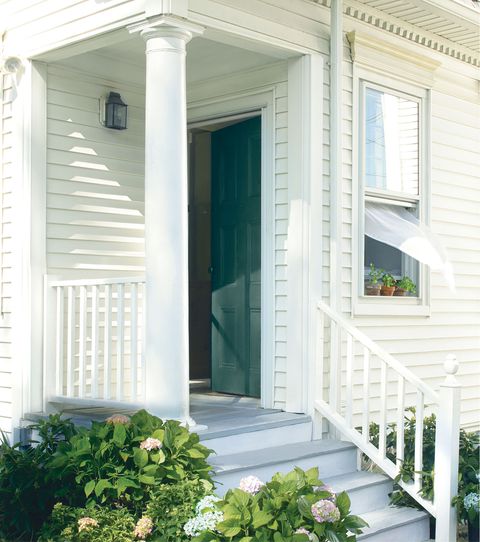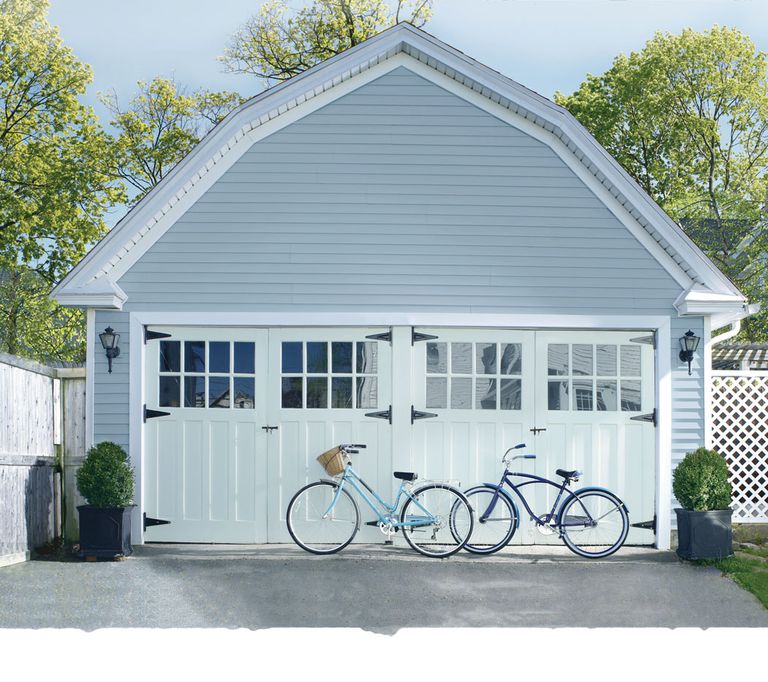Can You Paint Vinyl Siding?
Here’s what to know.
Look, we all wish we could have real wood clapboard, but the reality is, sometimes it’s just not in the budget (or on the rental). So, if you’re working with vinyl, what do you do? Well first, you’ll want to take good care of the siding, providing proper maintenance and cleaning. But, even if the vinyl in its best possible condition still leaves you unhappy, there’s good news: You don’t have to live with it that way. That is to say: Yes, you CAN paint your vinyl siding.
“The paint application process for painting vinyl siding is actually easier and can be less labor intensive than for wood, masonry, or hardboard painting projects, because vinyl siding does not retain moisture and can dry off rather quickly and can also be easier to clean,” says Mike Mundwiller, Field Development Manager for Benjamin Moore. But, like all renovation projects, there are some important things to know before you do.

1. Start with a clean surface
A good rule of thumb for anypaint project is to begin with a clean canvas. Of course, this is doubly important on an exterior, where your surface can be even dirtier and more weathered. If you’re working with a large area, your best bet is probably power washing, though you can also clean the surface by scrubbing with a stiff-bristle brush and rinsing it down. You can use a mild soap or laundry detergent, though if you want to go for a more specialty product, several paint companies do make cleaner.
“I always recommend using the Benjamin Moore N318 CLEAN,” advises Mundwiller. “This multi-purpose cleaner is safe for vinyl siding, and it removes grime and mildew stains. If you chose to use a pressure washer for cleaning, be sure that your water pressure isn’t too high, as this can result in damage to the vinyl siding. It is also important that care is taken so water does not enter the house around windows, doors, vents, soffits and any other openings.”
2. Determine if you need priming
Good news: Most of the time, you can skip right over the primer step on a vinyl paint job. According to Benjamin Moore, “only areas of pitted or porous vinyl siding must be primed.” Of course, you’ll also want to smooth out those areas. If you do decide to prime, use an adhesive primer.

Siding painted in Benjamin Moore’s Regal Select Revive in Icicle with a door in Tarrytown Green.COURTESY OF BENJAMIN MOORE
3. Choose the right paint
You won’t be able to lug that leftover interior paint out of the basement for this project, unfortunately: Since heat absorption from some colors can cause vinyl to expand, you’ll want to pick an acrylic paint that is deemed safe for vinyl, to prevent warping.
“Overall, when choosing a color, the safest bet is to choose a color that has a Light Reflective Value (LRV) greater than 55 percent,” Mundwiller advises. “LRV is a measurement that tells you how much light a color reflects, and conversely how much it absorbs. LRV runs on a scale from 0 percent to 100 percent. Zero being absolute black and 100 being a bright white or even a bright yellow. Most paint manufacturers list all their colors with the LRV values.
4. Use a professional
While some paint jobs are easy DIYs, this one is best left to the professionals. “It’s a tough homeowner project because the paint needs to go on smoothly,” painter Nancy Long told Angie’s List. “If you’re not applying an even coat—even if you’re diligent about the prep work—and you have no experience, it could [turn out poorly].”
5. Maintain it annually
While it’s smart to do annual washes on your painted home anyway, with vinyl it’s especially important, because it helps prevent grime buildup that could cause warping. Plan for an annual power wash, and your paint job should last for years.

About the author